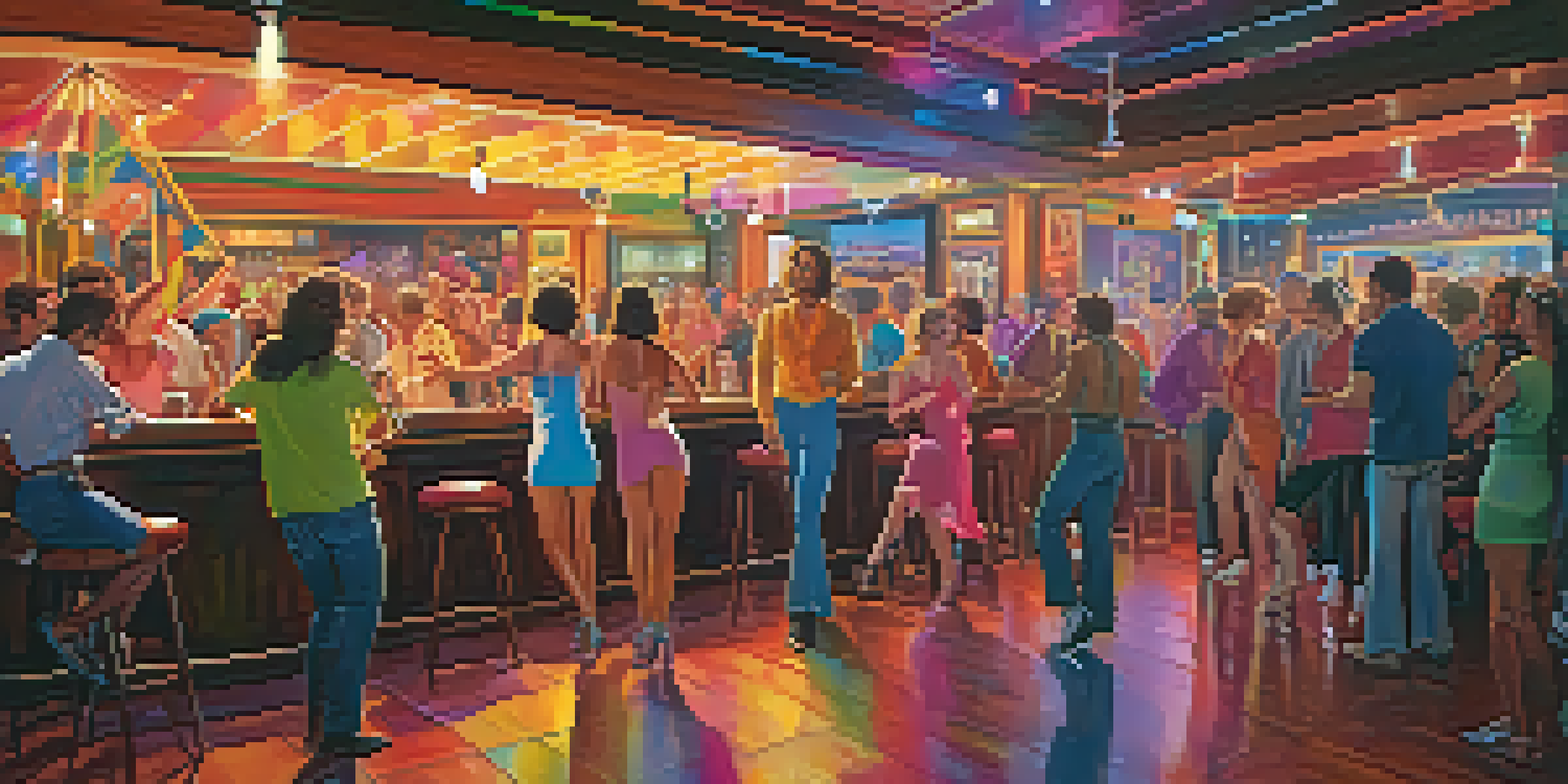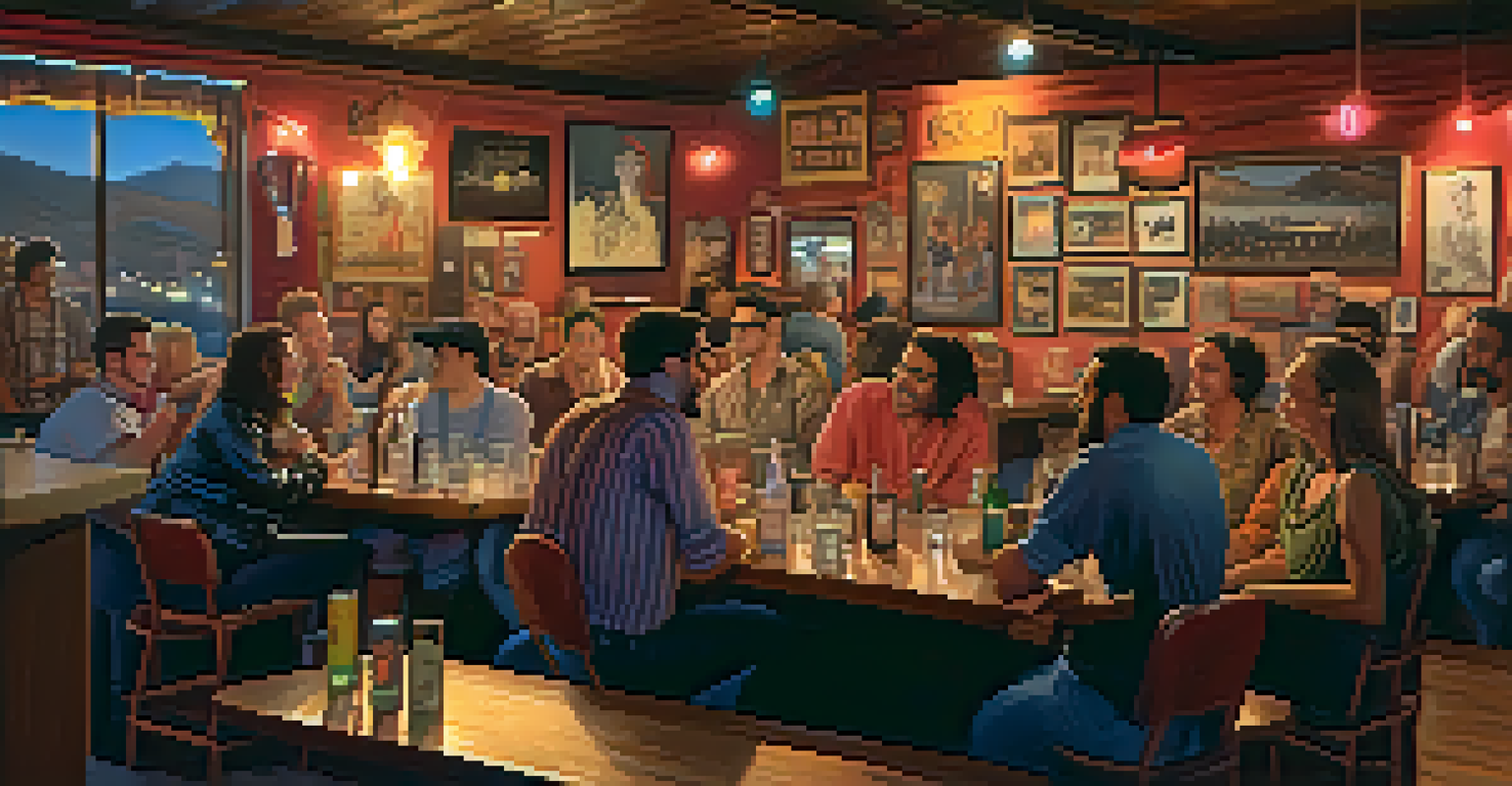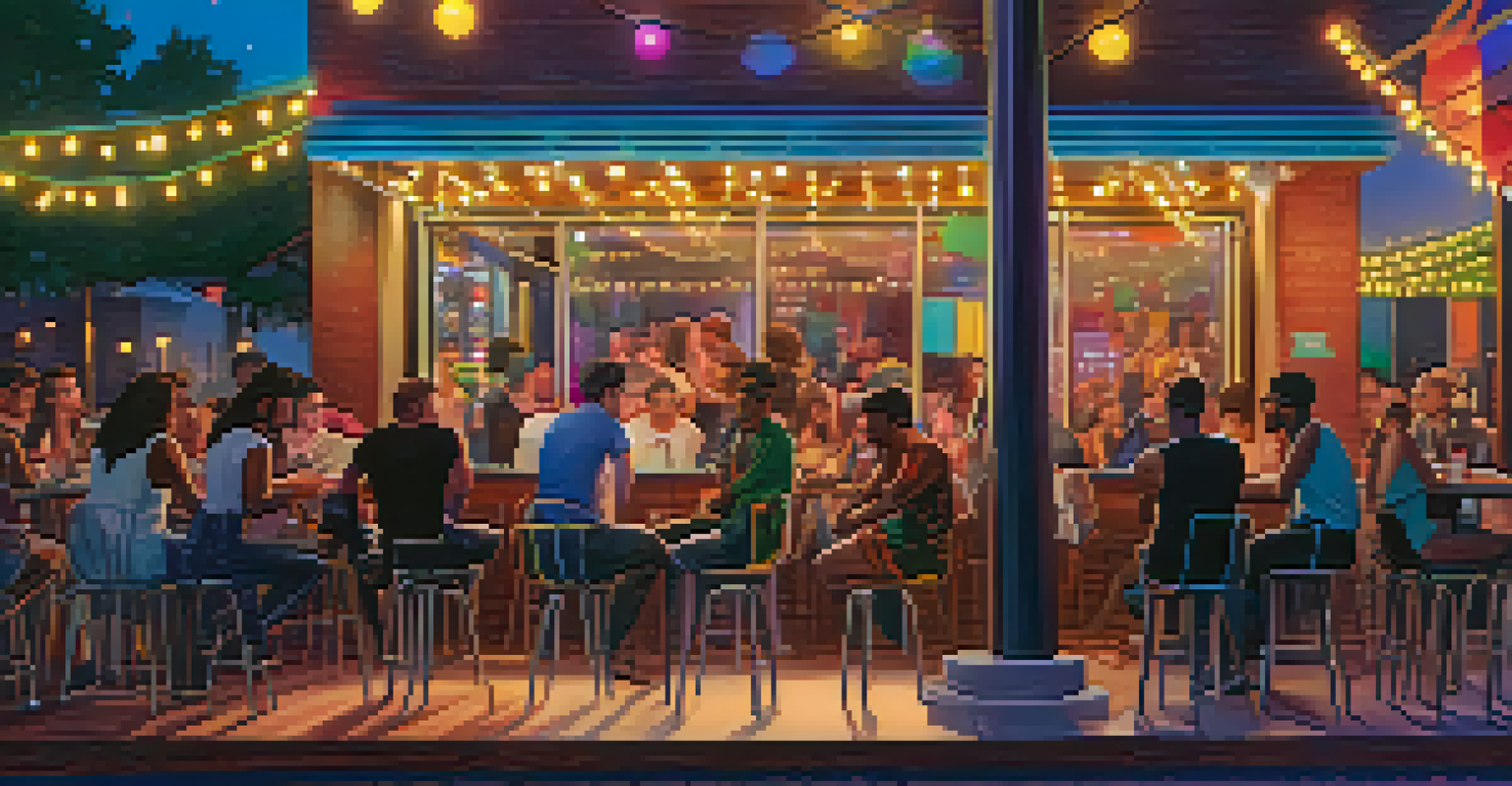Tucson's LGBTQ+ Bars: A Social History Through the Decades

The Early Days: A Foundation of Community in the 1960s
In the 1960s, Tucson's LGBTQ+ community began to find its footing, often gathering in private homes or underground venues. These spaces were vital for socializing, as public acceptance was minimal, and many faced discrimination. Bars like The Blue Moon emerged as safe havens, where individuals could express their identities without fear.
The only way to combat discrimination is to stand up and fight back. Community support is our greatest weapon.
These early establishments laid the groundwork for a supportive community, fostering connections through shared experiences. The atmosphere in these bars was often charged with a sense of rebellion against societal norms, creating a unique culture that still resonates today. The friendships formed in these spaces were not just social; they became crucial support networks.
While the 1960s were marked by secrecy and caution, they also ignited a spirit of activism. This groundwork set the stage for future generations to advocate for rights and visibility, making Tucson's LGBTQ+ bars symbols of resilience and hope.
The 1970s: Flourishing Scene Amidst Change
The 1970s brought a wave of change, with the LGBTQ+ community becoming more visible and vocal. Bars began to thrive, with establishments like The Copper Door becoming popular spots for dancing and socializing. This era was all about liberation, as patrons celebrated their identities openly, marking a significant shift from the previous decade.

As the disco craze took hold, LGBTQ+ bars became vibrant cultural hubs. The music was infectious, and the dance floors were filled with joy and expression, encapsulating the spirit of the time. These venues also hosted drag shows and performances, further solidifying their roles as centers of entertainment and community bonding.
Community Roots in the 1960s
The 1960s saw Tucson's LGBTQ+ bars emerge as safe spaces for expression, laying the foundation for a resilient community.
However, the decade was not without its challenges. The rise of the LGBTQ+ rights movement brought both progress and backlash, and bars became places of refuge and activism. The community's resilience shone through, as patrons united in their fight for equality, with bars serving as the backdrop for both celebration and protest.
The 1980s: Struggles and Solidarity in the Face of Adversity
The 1980s were a tumultuous time for the LGBTQ+ community, largely due to the AIDS crisis, which cast a long shadow over the bars of Tucson. Many establishments became centers for grieving and support, offering solace to those affected by the epidemic. The sense of community that had developed in previous decades deepened as friends and allies rallied together.
Diversity is not about how we differ. Diversity is about embracing one another's uniqueness.
Bars like The Oasis not only provided a space for socializing but also became hubs for fundraising and awareness efforts. Patrons organized events to raise money for AIDS research and support services, showcasing the power of solidarity in the face of adversity. This period highlighted the importance of community, as members leaned on each other for strength.
Despite the sorrow, the 1980s also saw the emergence of new voices in the LGBTQ+ scene. Activism flourished, with bars becoming venues for discussions on health, rights, and representation. This blending of socializing and advocacy helped shape a resilient community that refused to be silenced.
The 1990s: Celebrating Diversity and Acceptance
By the 1990s, Tucson's LGBTQ+ bars had evolved into vibrant spaces that celebrated diversity and acceptance. The community began to embrace a broader spectrum of identities, including those of different races, genders, and sexual orientations. Bars like The Rendezvous became known for their inclusive atmosphere, making everyone feel welcome.
This decade also marked a significant cultural shift, with events like Pride parades gaining traction. LGBTQ+ bars served as crucial sponsors and organizers, helping to raise awareness and visibility. The joy and celebration of identity permeated the air, as more people participated in these events and felt comfortable expressing themselves in public.
Activism and Solidarity in the 1980s
During the AIDS crisis, bars became crucial centers for support and activism, highlighting the community's strength in adversity.
As acceptance grew, so did the diversity of entertainment options within bars. Drag shows, karaoke nights, and themed parties became staples, creating spaces where people could express their creativity and individuality. The 1990s solidified Tucson's LGBTQ+ bars as essential parts of the social fabric, providing joy and camaraderie.
The 2000s: Progress in Rights and Representation
The 2000s marked a significant era of progress for the LGBTQ+ community, with bars playing a pivotal role in advocacy and representation. As same-sex marriage became a reality in many parts of the U.S., Tucson's LGBTQ+ bars celebrated these victories, hosting events that highlighted the importance of equality. These spaces became platforms for educating patrons about rights and the ongoing fight for justice.
This decade also saw the rise of more diverse narratives in LGBTQ+ culture, with bars welcoming a variety of performances and events. Open mic nights, art showcases, and film screenings became common, allowing local artists to share their stories and experiences. The bars transformed into cultural hubs, reflecting the richness of the community.
Despite the strides made, challenges remained, and bars continued to serve as spaces for activism. Many hosted discussions on issues like discrimination and mental health, demonstrating their commitment to social change. The 2000s reinforced the idea that LGBTQ+ bars were not just places to socialize; they were vital to the ongoing fight for equality.
The 2010s: Embracing Modernity and New Voices
As the 2010s rolled in, Tucson's LGBTQ+ bars embraced modernity, incorporating technology and social media into their operations. This shift allowed for greater outreach, helping bars connect with a new generation of patrons eager for community. Establishments began using platforms like Instagram to showcase events and celebrate diversity more visually.
Additionally, the decade saw the emergence of new voices within the community, including non-binary and genderqueer individuals. Bars responded by creating inclusive spaces that catered to a wider range of identities, ensuring everyone felt represented. This evolution highlighted the bars' roles as not just nightlife venues but essential community resources.
Evolving Inclusivity in the 2010s
The 2010s marked a significant shift towards inclusivity, as Tucson's bars adapted to represent a wider range of identities and engage in modern activism.
The 2010s also saw a resurgence of interest in activism, particularly around issues like transgender rights and intersectionality. Bars became sites for discussions and workshops, encouraging patrons to engage in activism and allyship. This period reinforced the idea that LGBTQ+ bars are vital for fostering community and advocating for social progress.
The 2020s: Resilience and the Future of LGBTQ+ Bars
Entering the 2020s, Tucson's LGBTQ+ bars faced unprecedented challenges, particularly during the COVID-19 pandemic. Many establishments had to adapt quickly, shifting to outdoor seating and virtual events to maintain connections within the community. This resilience showcased the bars' commitment to supporting their patrons, no matter the circumstances.
Despite the struggles, this decade also presents opportunities for innovation and growth. Bars are increasingly focusing on inclusivity, with many implementing policies and practices to ensure all individuals feel comfortable and safe. This commitment not only strengthens the community but also attracts a diverse clientele eager for supportive spaces.

As we look ahead, the future of Tucson's LGBTQ+ bars appears bright. With ongoing advocacy efforts and a dedication to celebrating all identities, these venues will continue to evolve and adapt. The legacy of support and community that has defined these bars for decades will undoubtedly guide them into the future, ensuring they remain vital parts of Tucson's social landscape.